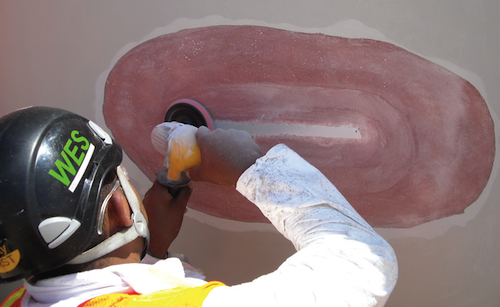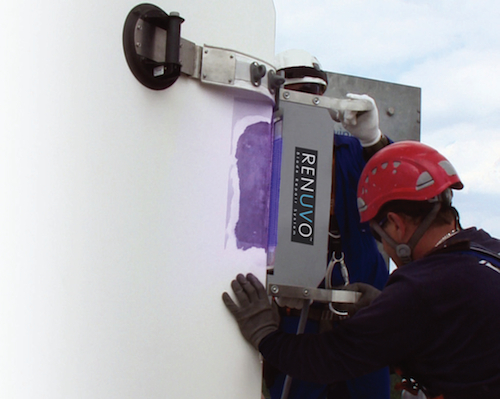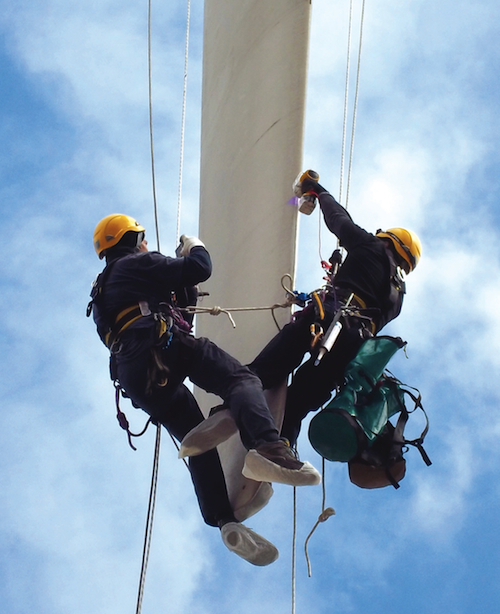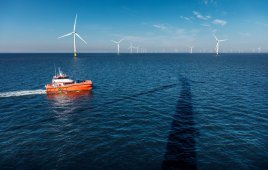Like stately giants, utility wind turbines are appearing further afield and offshore. As designers tackle the job of building longer, heavier, higher performing turbine blades, wind-farm operators and owners are faced with a different challenge– keeping aging blades in optimum condition.
Traditionally, less attention has been paid to the repair and upkeep of turbine blades versus other components. Instead, preventive maintenance programs have focused on the internal mechanics of turbines due to the predictability of their maintenance requirements. Typical preventive maintenance plans for internal components fall into 3, 6, and 12-month work schedules. By nature, blade repairs are more difficult to plan. Blade damage can arise in manufacturing, transportation, and tower construction and erection. However, maintenance issues more often occur in the field from leading-edge erosion, weather, and other factors. A lack of predictability and historical data complicates preventive maintenance for blades.

A maintenance technician from Wind Energy Services Company sands the substrate of a blade before applying a surface coat.
Commercial turbines can have tip speeds of over 200 miles per hour. At these speeds, rain drops can take on the impact of small stones, and blowing sand has the erosion power of a plasma cutter. Studies have shown blade roughness and accumulated debris on the blades can reduce wind turbine performance by 5 to 30%. Blades that aren’t working efficiently can also create vibration that contributes to gearbox failures.
While Composites One distributes composites and materials for blades and their repair, those who apply them have an entirely personal and unique perspective to the task–which is worthy of broader exposure. Hence, this article.
To minimize downtime and boost energy-capture efficiency, it’s critical to adopt practices early on, including implementing a preventive maintenance program and identifying problem areas. “Return on investment for wind turbines is a long cycle so any downtime has significant impact on the owner,” says Dave Smith, power generation manager for Composites One. “Repairs must be made quickly and cost effectively.”
Gary Kanaby, director of sales for Texas-based Wind Energy Services Company (WES) agrees. “A planned maintenance program can mean the difference between a small repair and damage that incurs the cost of an outside crew, crane rental, and the loss of energy sales while the turbine is down,” he says. “Leading-edge damage affects air foil and air flow around the blade and can cause up to a 5% energy loss.” Kanaby explains that uncorrected erosion will lead to cracking, splitting of the blade tip, and blade separation. Efficiency can be improved by restoring the leading edge to its original airfoil specs.
Visual inspection is the simplest form of preventive maintenance and can be conducted using a camera with a telescopic lens of at least 400 mm, or high-powered binoculars. Joshua Crayton is blade services manager for Rope Partner, which provides turbine maintenance, repair, and inspection services throughout its locations in California, Texas, Canada, and Germany. He says regular inspections are especially important in windy seasons and following lightning storms. “Operators and owners are inheriting their wind farm assets and the responsibility of maintaining blades that are no longer covered by the OEM warranty,” he says. “Like any business, wind farm owners and operators typically run a lean staff and may not have an experienced maintenance technician in-house. Partnering with a service company can help them design a long-term, post warranty, preventive maintenance plan.”
According to Crayton, a maintenance plan should be initiated before the warranty period expires. “A thorough internal and external blade inspection should be scheduled in the warranty period,” he says. “Once owners and operators take over care of a wind farm, these inspections should take place every two years. Personnel can conduct simple ground inspections while on-site, but there is no substitution for a close, visual examination performed uptower.” Trained personnel using standard rope access systems offer an efficient, cost effective, environmentally friendly approach that enables complete 360° access to the tower, nacelle, and blades.
Crayton says consultation can still offer practical insights for wind-farm owners with the capbility to perform blade inspection and repairs in-house. “There are many different types of blades in the field,” he says. “Each construction type carries its own inherent flaws and issues. Consultants can give wind-farm owners an understanding of what to look for. A defect that may be potentially catastrophic for one type of blade may not be as serious for another.” Water ingress, for example, will not have the same impact on a blade core made from polymer foams as it would a blade built predominantly with a balsa-wood core.
Over the last year Crayton’s crew has begun to see an increase in requests from owners and operators for internal and external blade inspection on a site-wide basis. “When we make repairs we are always trying new products to find more efficient ways to get the turbine up and running faster,” he adds. For small fixes such as minor pitting or cleaning debris off blades, technicians can use a variety of abrasives, cleaning solutions, and fillers.

Structural repairs are more often made in the field. Products, such as the Renuvo line from Gurit, allow for prepreg patching right on the blade.
Jim Sadlo, wind energy market development manager for 3M, says some wind farm owners monitor their blades using high-speed telephoto cameras. “The stop action images offer enough clarity to reveal problem areas such as leading edge erosion and other defects on the blade,” he says. Typically, the next step is a visual blade inspection by a service company who analyzes the scope of work and determines the required materials. Wind farms, especially those in Northern climates, have a short window of opportunity to complete repairs. For example, restoring surface damage can require a number of steps. The crew usually masks off the portion of the blade surrounding the work area. A plastic film attached to masking tape works effectively and is easy to haul uptower, says Sadlo. The defective portion of the blade is cut out and then ground using ceramic grinding abrasives. The area has to be rebuilt with fabric and resin according to OEM criteria for strength, density, and structural soundness. After placing the last layer of fabric, filler helps restore the blade’s aerodynamic shape. Several epoxies and polyurethanes are available in easy-to-handle cartridges that offer short cure times. A repair technician can begin sanding in as little as 30 minutes.
Once the repaired section is sanded and painted, wind protection tape can be applied and the tape’s edges sealed and beveled to create optimal aerodynamic characteristics. Sadlo says the tape can also act as a shock absorber to lessen the impact of flying debris such as bugs or hail. This wind protection tape has a new option that allows for easy installation while the blade is vertical. The center section of the tape’s liner can be removed separately from the rest of the liner, making it easier to align to the blade edge and apply the tape from the middle.

When looking for advice on maintenance or repair products, the following companies can offer both materials and expertise.
Resins that cure quickly with UV light instead of heat also help reduce the time crews have to wait between repair steps. David Cripps, global account manager for Gurit Wind Energy says such resins broaden the window for repairs in colder climates because they can be used at temperatures as low as freezing. Available in a paste or prepreg patch, the resin paste can be used on its own to make small repairs. If a laminate must be restored to its original condition, the resin paste can also be used as a primer or wetting agent to help bond the new prepreg–a relatively dry material–to the blade surface. Once the prepreg patch is applied, additional paste can smooth the surface. “With the prepreg method, the amount of resin in the laminate is highly controlled for an accurate fiber-resin ratio,” he says.
Improved materials, such as coatings, are helping wind farm owners and operators maximize the resistance of their blades to the elements and extend service life. Applied to the blade’s exterior by the OEM, these newer coatings can also be reapplied uptower to facilitate a repair. Martin Schoning, sales manager for Bergolin, says the products are fast drying and environmentally friendly. “The blade’s leading edge takes the brunt of damage from erosion, weather elements, and airborne particulates,” he says. “Re-application of the right coating is a key step to increasing the blade’s resistance to abrasion and erosion.”
The need for products that can be used in the field under less than ideal conditions is a component of preventive maintenance. “Turbine downtime costs a lot of money,” says Alistair Smith, technical sales manager for Mankiewicz. “Paints and top coats offer abrasion resistance and absorb some of the energy from sand, hail or any other element that hits the surface. The products must dry fast and last a long time. Delivery systems also have to make the products easy to handle, transport, and use uptower.”
As the industry grows, regular inspection and maintenance of blades, along with products that can support fast fixes are becoming critical tools for minimizing costs associated with reduced efficiency and downtime. “The blade is really the ‘engine’ of the turbine,” says Smith, “it’s the component that is capturing and producing energy. Planned maintenance can keep blades in peak performance which directly translates to kilowatts sold.”
Marcy Offner
Composites One
Arlington Heights, IL
www.compositesone.com
WPE
Filed Under: O&M





I am a Senior Wind Power Engineer from Jacobs Engineering (formerly Sinclair Knight Merz) and I have been specialising in blade maintenance and condition optimisation for nearly 10 years. I have recently created a software to track and report on blade condition as currently there is not a robust system to comprehensively submit, track, repair and report on blade defects. We have over 4,000 registered defects logged in the system as of today and are gaining momentum quickly. Blades appear to have been overlooked for routine maintenance, even though they can cost anything up to and sometimes above NZ$1,000,000 per blade.
Due to the sudden awareness of blades causing power curve reductions, increased noise and the possibility of defects causing tremendous amounts of downtime; more attention is now being paid to the rotor in general. What is also concerning with this boom is the quantity of skilled and experienced technicians and engineers. To address this we have also created an accreditation scheme to weed out the fly-by-nights and cowboys currently present in the industry.
If you write, I’ll review, edit, and maybe, publish.